Abstract
The article deals with the problem of early detection of gifted children of the Far North and the creation of conditions for their development through additional education. In their study, the authors relied on the concept of giftedness of Bogoyavlenskaya D. B., Leites N. S, Shadrikov V. D., developed in 1998. To identify the problem field, an analysis was made of statistical data on the Republic of Sakha (Yakutia) about the activities of institutions education in the period from 2011 to 2017, which showed the dynamics of the increase in the number of supplementary education institutions from 218 to 228 institutions and the coverage of children from 55.5% to 63%. During the analysis of monitoring data, the increase in the number of associations and the number of students was influenced by such factors as the implementation of the federal program for the development of additional education for 2016-2020 and the decision by the republic's leadership to create a network of Children's Technoparks «Quantorium» for 2017-2019. The survey showed that there is an urgent need for scientific and methodological support for teachers of additional education and strengthening the material and technical base. Digitization and the emergence of new trends in circle activities — robotics, modeling, IT circles, and quantoriums — were highlighted by a positive trend. All results are presented in the form of diagrams with conclusions.
Keywords: Giftednessgifted childrencriteria for giftednessadditional educationfeatures of the Far North
Introduction
In the light of modern educational reforms in our country, the problem of early detection of gifted children and creating conditions for their development is quite acute. Consider the concept of «giftedness» from the standpoint of different approaches. Often giftedness is meant as success in the future life. But, in our opinion, the «gifted» is not «effective». Gifted children could be almost all children, according to researchers. In 1998, the concept of giftedness was developed. The authors were Bogoyavlenskaya, Leites and Shadrikov. They identified five criteria for giftedness: the first is a distinction by type of activity (spiritual and moral, theoretical, communicative, artistic and aesthetic); the second is in the degree of forcing (potential endowments and actual); the third is in the form of manifestation (hidden and obvious endowments); the fourth is the latitude of the manifestation spectrum in various activities (special and general endowments); the fifth is giftedness depending on age (late, early) (Bogoyavlenskaya & Bogoyavlenskaya, 2005; Bogoyavlenskaya & Shadrikov, 1998; Leytes, 2001, 2003; Shadrikov, 2007, 2010).
But there are interesting controversial cases when they can be excluded from the number of gifted children from school. Only a small percentage of children become successful. Despite of the fact that adults expect and hope success from children, not all of them can show themselves, to shine with erudition in competitions and in Olympiads.
As practice shows, those kinds of children need help, a push from an experienced teacher in order for him to show his capabilities. It is necessary to introduce special programs that will implement a favorable realization of giftedness. English psychologist has calculated the most hundred different definitions of this property. Making an analysis of research Teplov (1985), Panov (2005, 2006, 2007), Kerr & Huffman (2018), Vogelaar & Resing (2018), Warne (2016) it can be concluded that the main idea of studying this issue is the need to create a long-term developing approach to gifted children
Problem Statement
The current task for teachers is to identify and raise gifted children among the rest. Nowadays, due to giftedness, there are many studies and points of view; in aggregate, they all make it clear and determine the best strategy for choosing interaction and development of gifted children. It should be noted that taking into account the psychological characteristics of gifted children and the adaptation of the learning process in accordance with their individualities and features do not always lead to positive results. Gifted children need an individual approach. Sometimes it happens that the teacher does not have enough theoretical training, practical experience, combat work, to lose status, to work unprofessionally with erudite, initially thinking students. A child may have a learning motive - a mismatch between cognitive needs and a real curriculum. Attention deficit hyperactivity disorder (Androsova, Petrova, & Popova, 2018). Heredity, the influence of the social environment, the child’s own activity contribute giftedness development. Some researchers believe that under the benign conditions of any child can be developed to the level of giftedness (McBee, Makel, Peters, & Matthews, 2018). It is difficult to say whether the endowment of a child in an older age is preserved. Sometimes a high level of child abilities does not lead, unfortunately, to high results of their activities. The purpose of our study is to show, through analysis of statistical data and a survey, to study the state of the working system with gifted children through additional education institutions
Research Questions
-
Analysis of the dynamics on the development of the additional education system in the Republic of Sakha (Yakutia).
-
Identification of problems and prospects for the development of gifted children through additional education in the conditions of the Far North
Purpose of the Study
In our study, we examined one of the regions of the Far North - the Republic of Sakha (Yakutia), which is in accordance with the laws of the Russian Federation. According to the Constitution of the Republic of Sakha (Yakutsk) in the territory of the Republic of Sakha (Yakutsk), 34 ulus (district) and their constituent 364 villages (rural districts), 12 cities of ulus (district) and republican subordination, 42 villages (urban-type settlements) and 586 villages (population of settlements).
Regional features of the Republic of Sakha (Yakutia) include: a sharply continental climate with a large difference in seasonal temperatures, a relatively short summer and a long winter, a vast territory with a complex transport system and communication, remoteness of settlements, a small number of people, also there are 3 time zones, which also can be attributed to the peculiarities of the region. Despite of the difficult living conditions in the republic, a work system with gifted children has been built through additional education. We analyzed the work in the field of additional education in the republic from 2011 to 2017 on the basis of annual statistical data presented in the public domain and using queries
Research Methods
-
The authors analyzed statistical data of monitoring the organization and implementation of additional education in the Republic of Sakha (Yakutia) from 2011 to 2017
-
A survey was conducted with teachers and students of three districts groups of the Republic of Sakha (Yakutia) to identify problems and prospects for the development of gifted children through additional education in the conditions of the Far North
Findings
Regional features of the Republic of Sakha (Yakutia) include: a sharply continental climate with a large difference in seasonal temperatures, a relatively short summer and a long winter, a vast territory with a complex transport system and communication, remoteness of settlements, a small number of people, also there are 3 time zones, which also can be attributed to the peculiarities of the region. Despite of the difficult living conditions in the republic, a work system with gifted children has been built through additional education. We analyzed the work in the field of additional education in the republic from 2011 to 2017 on the basis of annual statistical data presented in the public domain and using queries.
Additional education in the republic is represented by 228 organizations that belong to the following departments: the Ministry of Education and Science of the Republic of Sakha (Yakutia), the Ministry of Culture and Spiritual Development of the Republic of Sakha (Yakutia), the Ministry of Sports of the Republic of Sakha (Yakutia), and non-governmental institutions of additional education of children.
In general, from 2011 to 2017, there has been a slight increase in the number of additional education institutions from 218 to 228 institutions in the republic (see figure
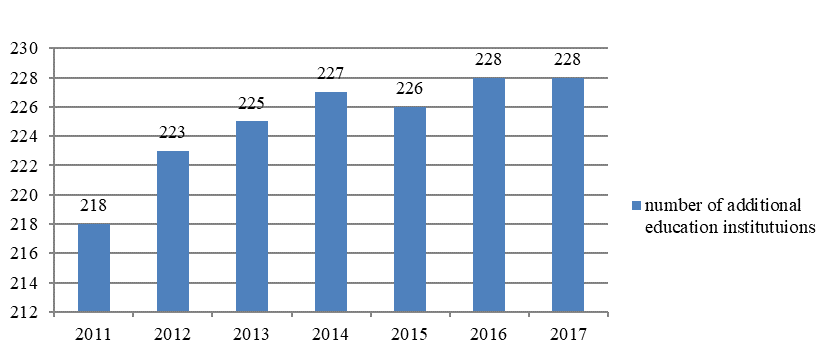
From figure
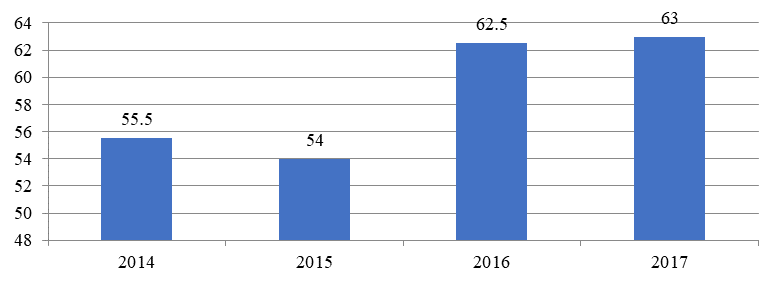
Figure
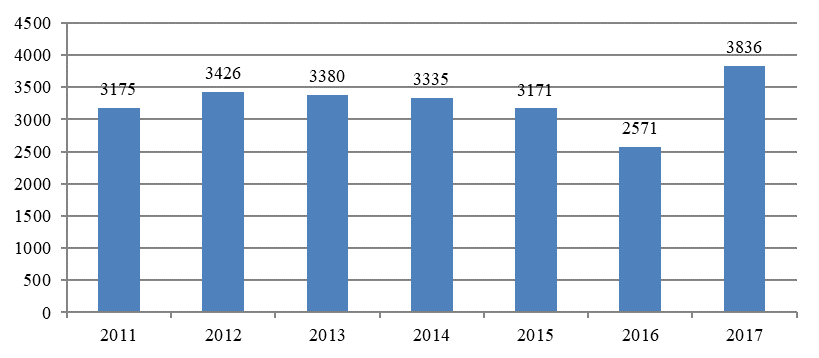
According to figure
The Republic of Sakha (Yakutia) - is in among 9 regions of the Russian Federation for the development and implementation of a new model for personalized supplementary education for children for 2016-2020 (Russian subsidy - 31 million rubles, from the State Budget of Yakutia) - 19 million.rub.
Yakutia is in among the 17 regions for financial support of the event 3.5. “Creating conditions ensuring the availability of additional general education programs of natural science and technical orientation for students” of the Federal Target Program for the Development of Education for 2016-2020, (Russian grant 57 million rubles, from the State Budget of Yakutia -24 million rub.).
The decrease in the number of associations and the enrollment of children in 2016 is due to different reasons. For example, due to changes in the structure of the institution, optimization, lack of specialists, etc.
To ensure the availability of additional general educational programs for the natural science and technical orientation of students in the Republic of Sakha (Yakutia), the Head of the Republic of Sakha (Yakutia) decided to create a network of Children's Technoparks «Kvantorium» for 2017-2019, which affected the increase in the number of associations and the number of students (see figure
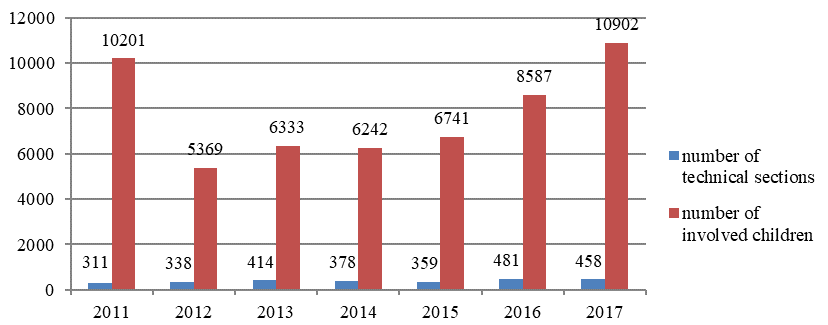
As figure
If in 2011 there were only 311 sections, then in 2017 their number increased by 147 units and was 458. At the same time, the total number of children involved in these sections, after a sharp decline in 2012, gradually increases. If in 2011, on average, there were 33 children in a section, in 2015, on average, 19 children. This can be explained by the technologization and individualization of education, and the equipment of technical creativity sections has also recently improved.
According to scientific and technical creativity, the greatest activity and effectiveness are shown by Vilyuisky, Ust-Aldansky, Khangalassky, Gorny, Megino-Kangalassky, Nyurbinsky, Churapchinsky districts and Yakutsk. If we compare 2013 and 2015, we see that the geography of technical competitions in the republic has expanded. In addition to the central, river and Vilyuisk group districts, the Arctic districts, Zhigansky, Tomponsky, are also actively connected.
However, it should be noted that the scientific and technical creativity of children requires huge material costs. The material and technical base of centers for scientific and technical creativity does not meet modern requirements.
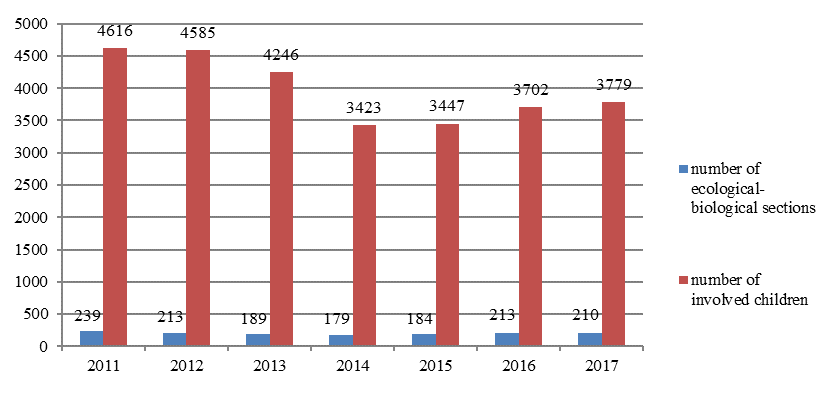
According to figure
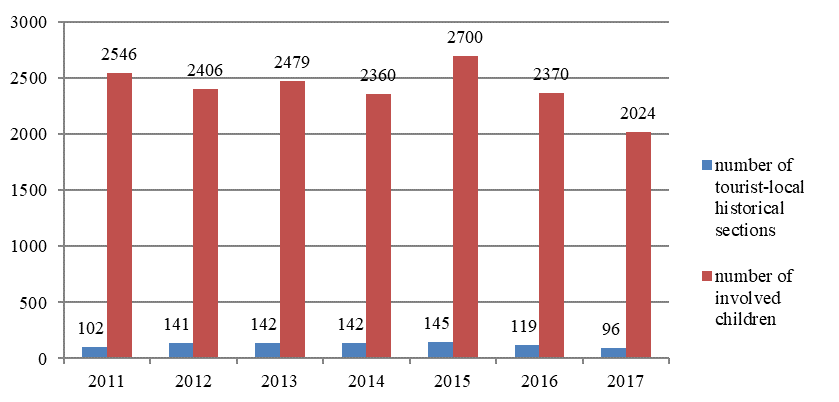
Recently, the number of people employed in tourist - local historical sections has decreased (in 2017 compared to 2011 - by 522 children, a decrease of 21%)
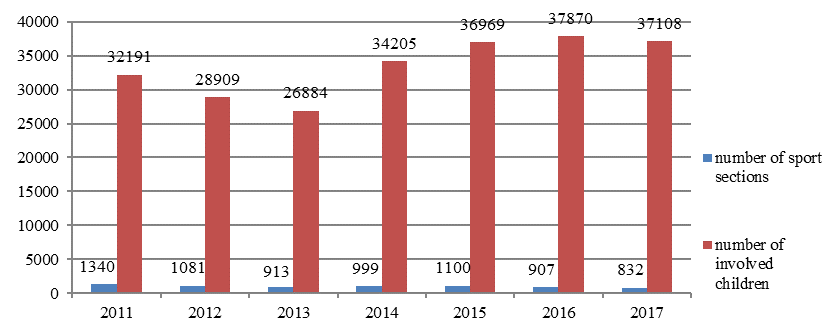
Based on data from figure
From figure
Within the framework of the Forum of music teachers and fine arts of the Republic of Sakha (Yakutia), the republican project «Draw All» was launched (see figure
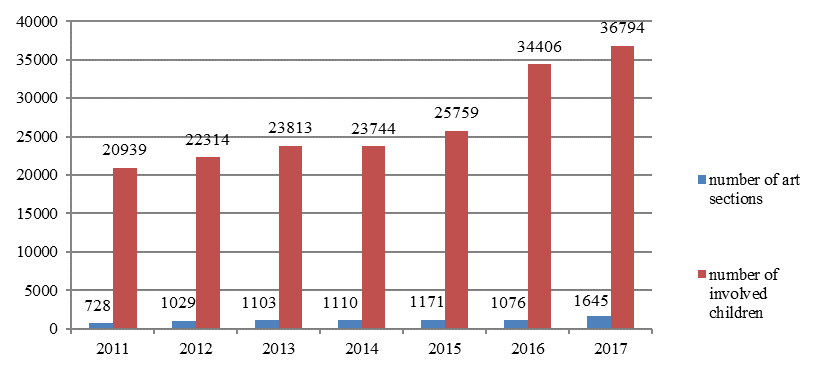
If in 2011 there were only 728 sections and 20939 children were involved, then in 2017 the number of sections was 1645 (an increase of 917 units), and the number of students increased by 15855 children, which is an increase of 16.3%. It can be concluded that over the past 7 years, children have become more interested in art.
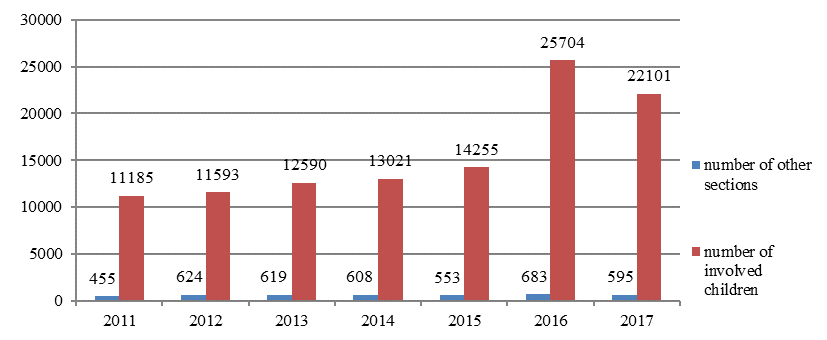
As figure
Statistical data was analyzed, and a survey was conducted of teachers and students in the republic in order to study in more detail the work of children in the system of additional education under the conditions of the Far North. A survey among educators gave the following picture, which we reflected in the diagrams below.
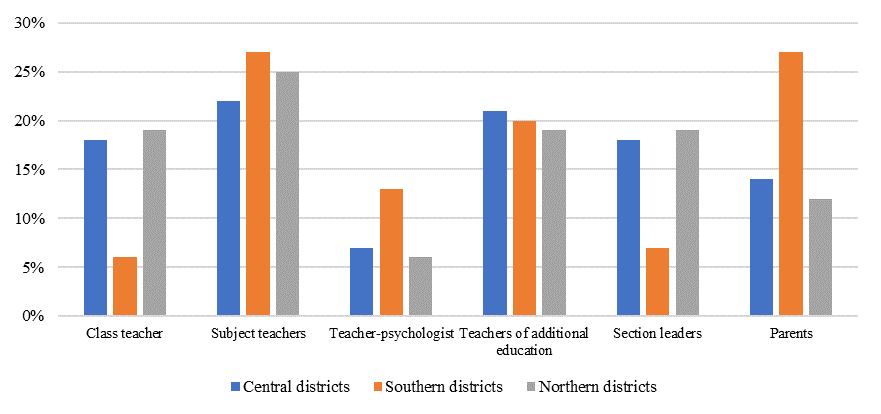
To the question: «Who should contribute to the identification of gifted children? ». Teachers from the Central districts of the Republic of Sakha (Yakutia) consider: the class teacher-18%, subject teachers-22%, teachers of additional education - 21%, section leaders-18%, parents -14%. Teachers from the Southern districts of the Republic emphasized the special role of identifying giftedness: class teacher-6%, subject teachers-27%, teacher-psychologist-13%, teachers of additional education-20%, section leaders -7%, parents -27%. Teachers from the Northern districts indicated in the questionnaires: the class teacher - 19%, subject teachers - 25%, teacher-psychologist - 6%, supplementary education teachers - 19%, section leaders - 19%, parents -12% (see figure
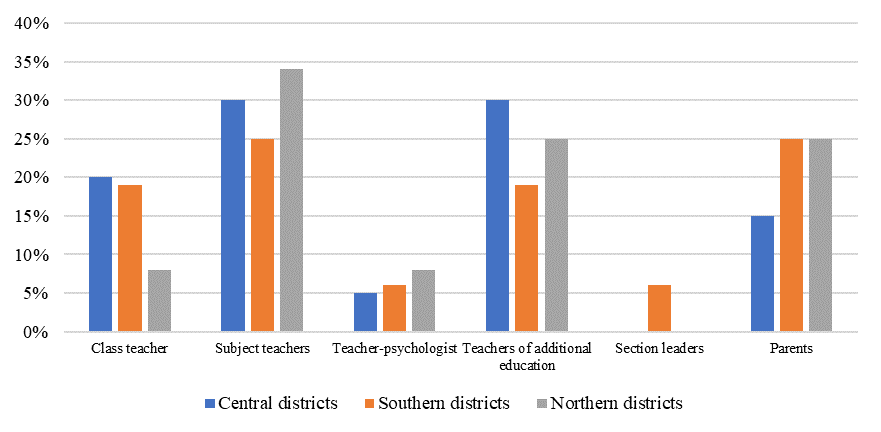
To the question: «Who should contribute to ensure the development of giftedness and its realization into real achievements? ». Teachers from the Southern districts of Yakutia in the questionnaires indicated the following answers: class teacher -20%, subject teachers -30%, teacher-psychologist-5%, supplementary teachers-30%, section leaders -6%, parents - 25% (see figure
To the question: «What are the most significant achievements in your work with gifted children? ». Teachers consider participation in scientific conferences and competitions.
To the question: «Which sections are conducted in the school for additional education? » The following sections are conducted in the schools of the central districts of the republic: project activities, basketball, volleyball, dance studio, vocal studio, needlework, robotics, design, modeling, visual arts, chess, IT sections. In the Northern districts of Yakutia, the following groups are held in schools for additional education: design activities, robotics, designing, modeling, basketball, volleyball, a dance studio, a vocal studio, needlework, and fine craftsmanship.
To the question: «How to improve the work with gifted children? ». Teachers from the central districts of the republic propose to build schools with a special education, to provide additional staff while working with gifted children in secondary schools. In the northern districts of Yakutia, teachers believe that in order to improve the quality of work with gifted children, it is necessary to open short-term courses, seminars on working with gifted children, and to create quanteriums in each locality. Teachers from the southern districts of Yakutia are proposing to create several more bases, for example, «Lensky Krai» and create alternative conditions for working with gifted children.
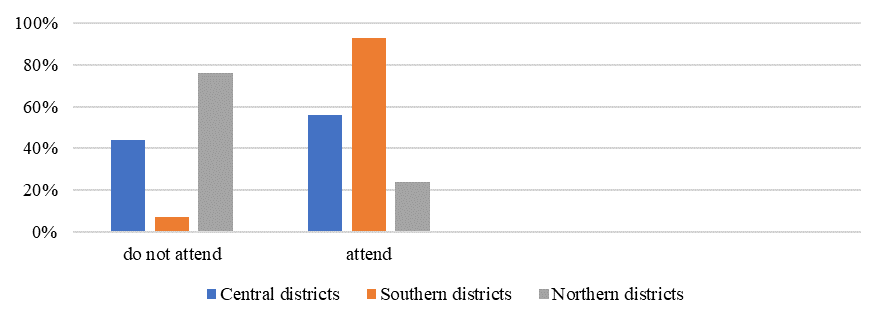
Teachers from the Central districts of the Republic do not attend elective courses, elective courses - 44%, actively attend -56%; teachers from the Southern districts of the Republic do not attend -7%, attend -93%; teachers from the Northern districts of the Republic do not attend electives - 76%, 24% attend (see figure
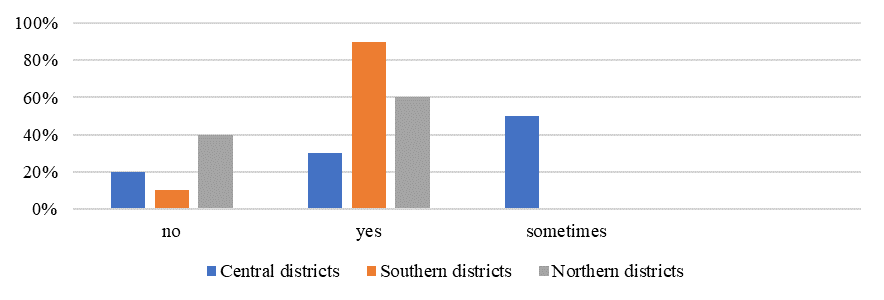
A survey conducted among students of Republican schools showed the following results, which we also reflected in the form of diagrams.
Students from the Central districts of the Republic participate in subject Olympiads -30%, sometimes 50%; do not participate -20%; students from the southern regions participate - 90%; do not participate -10%; from the Northern districts, students participate in subject Olympiads - 60%, 40% do not participate (see figure
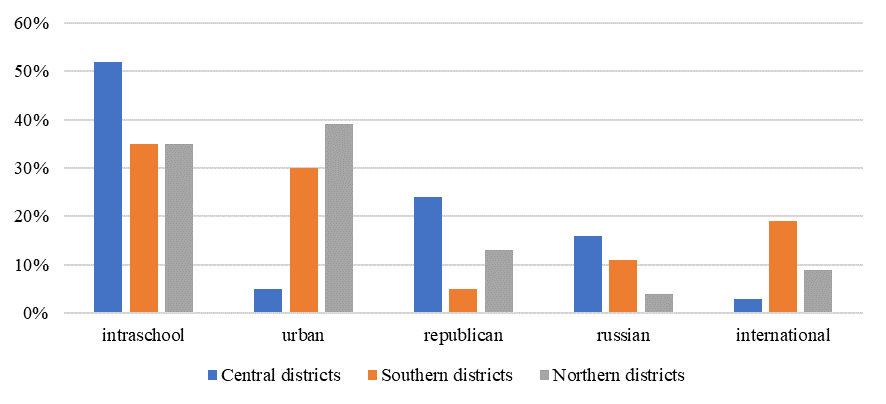
The survey results about student participation in competitions showed the following results: students from the Central districts of Yakutia participate in the following competitions: intraschool -52%, urban -5%, republican -24%, Russian -16%, international -3%; students from the South districts of Yakutia: -35% intra-school, districts -30%, republican -5%, Russian -11%, international -19%; schoolchildren from the Northern ulus of the RS (Y): -35% intra-school, districts -39%, republican -14%, All-Russian -4%, international -9% (see figure

A survey of students about their participation in conferences showed the following results. Pupils from the central regions of the republic participate in scientific conferences -20%, -16% do not participate; pupils do not participate in scientific conferences in the southern districts of the republic —57%, 43% participate, pupils do not participate in conferences in the northern districts of Yakutia —68%, and 32% actively participate (see figure
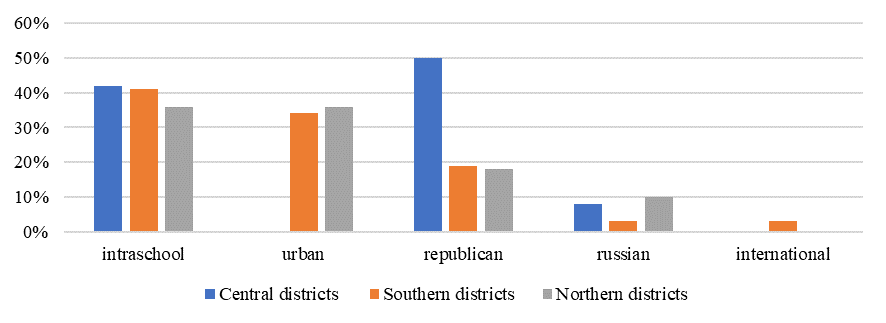
In the central regions of the republic, schoolchildren participate in the following conferences: intraschool - 42%, urban -0%, republican - 50%, All-Russian -8%. Students from the Southern districts of Yakutia actively participate in conferences: intraschool -41%, district -34%, republican -19%, All-Russian -3%, international -3% Students from the Northern districts participate in the following conferences: intraschool -36%, district -36%, republican -18%, All-Russian -10%, international -0% (see figure
Conclusion
Survey data showed that:
according to teachers, subject teachers, teachers of additional education, class teachers and parents should contribute to the identification of gifted children;
the development of giftedness and its implementation in real achievements should be provided by teachers - subjects, teachers of additional education, class teachers, parents;
Teachers characterize the active participation of gifted children in scientific conferences, competitions and olympiads as meaningful achievements and results of their work (thanks to IT technologies, gifted children can actively, remotely participate in numerous competitions, olympiads and conferences of different levels);
a variety of sections provides opportunities for the development of gifted children in the conditions of the Far North;
there is a need to improve the material base of institutions of additional education in accordance with modern trends - circles of robotics, modeling, design, IT-circles, quantoriums, etc.;
teachers note the need for refresher courses for working with gifted children;
The results of the study give reason to conclude that there is an increase in the number of institutions of additional education, growth of technical sections, digitalization, the emergence of non-governmental institutions of additional education and, as a minus, I would like to note a decrease in the number of sections of environmental and tourist-local history
References
- Androsova, M. I., Petrova, S. F., & Popova, S. Y. (2018). Rabota s odarennymi det'mi v Respublike Saha (Yakutiya) [Work with gifted children in the Republic of Sakha (Yakutia)]. Problemy sovremennogo pedagogicheskogo obrazovanija, 62(2), 15-20. [in Rus].
- Bogoyavlenskaya, D. B., & Bogoyavlenskaya, M. E. (2005). Psihologiya odarennosti: ponyatie, vidy, problem [Psychology of giftedness: concept, types, problems] (Vol. 1). Moscow: MIOO. [in Rus].
- Bogoyavlenskaya, D. B., & Shadrikov, V. D. (1998). Rabochaya koncepciya odarennosti [Working concept of endowments]. Moscow: Enlightenment. [in Rus].
- Kerr, B. A., & Huffman, J. M. (2018). Gender and Talent Development of Gifted Students. In S. I. Pfeiffer (Ed.), Handbook of Giftedness in Children (pp. 115-128). Cham, Switherland: Springer.
- Leytes, N. S. (2001). Vozrastnaya odaryonnost' shkol'nikov [Age talent of schoolchildren]. Moscow: Academy. [in Rus].
- Leytes, N. S. (2003). O priznakah detskoj odaryonnosti [On the signs of child giftedness]. Voprosy psihologii (Questions of psychology), 4, 13. [in Rus].
- McBee, M. T., Makel, M. C., Peters, S. J., & Matthews, M. S. (2018). A Call for Open Science in Giftedness Research. Gifted Child Quarterly, 62(4), 374-388.
- Panov, V. I. (2005). Odarennost' i odarennye deti: ekopsihologicheskij podhod [Giftedness and gifted children: an ecopsychological approach] [Monograph]. Moscow: PFUR. [in Rus].
- Panov, V. I. (2006). K probleme vyyavleniya (identifikacii) odarennyh detej [To the problem of identifying gifted children]. Vestnik prakticheskoj psihologii obrazovanija (Bulletin of practical psychology of education), 4, 34–38. (in Russ.).
- Panov, V. I. (2007). Obrazovatel'naya sreda i motivaciya uchashchihsya v uchrezhdenii dopolnitel'nogo obrazovaniya [Educational environment and motivation of students in the institution of additional education]. Vestnik prakticheskoj psihologii obrazovanija, 2, 22–29. [in Rus].
- Republican Resource Center «Young Yakutians» (2014). Monitoring organizacii dopolnitel'nogo obrazovaniya detej v uchrezhdeniyah dopolnitel'nogo obrazovaniya MOiN RS (YA) za 2014 god (forma 48) [Monitoring of the organization of additional education of children in institutions of additional education of the Ministry of Education and Science of the Republic of Sakha (Yakutia) 2014 (form 48)]. Retrieved from-http://www.sakhaedu.ru/teachers/analizimonitoringDOD. [in Rus].
- Republican Resource Center «Young Yakutians» (2015). Monitoring realizacii dopolnitel'nyh obshcheobrazovatel'nyh programm v uchrezhdeniyah dopolnitel'nogo obrazovaniya detej Respubliki Saha (YAkutiya) za 2015g.(po FSN №1-DO) [Monitoring the implementation of additional educational programs in institutions of additional education for children of the Republic of Sakha (Yakutia) 2015. (federal statistical observation of additional education №1)]. Retrieved from- http://www.sakhaedu.ru/teachers/analizimonitoringDOD [in Rus].
- Republican Resource Center «Young Yakutians» (2016a). Monitoring organizacii dopolnitel'nogo obrazovaniya detej v uchrezhdeniyah dopolnitel'nogo obrazovaniya MOiN RS (YA) za 2016 god (forma 48) [Monitoring of the organization of additional education of children in institutions of additional education of the Ministry of Education and Science of the Republic of Sakha (Yakutia) 2016 (form 48)]. Retrieved from-http://www.sakhaedu.ru/teachers/analizimonitoringDOD [in Rus].
- Republican Resource Center «Young Yakutians» (2016b). Monitoring realizacii dopolnitel'nyh obshcheobrazovatel'nyh programm v obrazovatel'nyh organizaciyah Respubliki Saha (YAkutiya) za 2016g. (FSN №1-DO, 1-DOP, forma 48) [Monitoring the implementation of additional educational programs in educational institutions of the Republic of Sakha (Yakutia) 2016. (federal statistical observation of additional education form 48)]. Retrieved from- http://www.sakhaedu.ru/teachers/analizimonitoringDOD [in Rus].
- Republican Resource Center «Young Yakutians» (2017a). Monitoring organizacii dopolnitel'nogo obrazovaniya detej v uchrezhdeniyah dopolnitel'nogo obrazovaniya MOiN RS (YA) za 2017 god (forma 48) [Monitoring of the organization of additional education of children in institutions of additional education of the Ministry of Education and Science of the Republic of Sakha (Yakutia) 2017 (form 48)]. Retrieved from-http://www.sakhaedu.ru/teachers/analizimonitoringDOD. [in Rus].
- Republican Resource Center «Young Yakutians» (2017b). Monitoring realizacii dopolnitel'nyh obshcheobrazovatel'nyh programm v uchrezhdeniyah dopolnitel'nogo obrazovaniya detej Respubliki Saha (Yakutiya) za 2017 god (FSN №1-DO) [Monitoring the implementation of additional general education programs in institutions of supplementary education for children of the Republic of Sakha (Yakutia) 2017 (federal statistical observation of additional education №1)]. Retrieved from http://www.sakhaedu.ru/teachers/analizimonitoringDOD [in Rus].
- Republican Resource Center «Young Yakutians» (2017c). Monitoring realizacii dopolnitel'nyh obshcheobrazovatel'nyh programm v obrazovatel'nyh organizaciyah Respubliki Saha (YAkutiya) za 2017 god (FSN №1-DOP) [Monitoring the implementation of additional educational programs in educational institutions of the Republic of Sakha (Yakutia) 2017 (federal statistical observation of additional education №1)]. Retrieved from- http://www.sakhaedu.ru/teachers/analizimonitoringDOD [in Rus].
- Shadrikov, V. D. (2007). Mental'noe razvitie cheloveka [Mental development of human]. Moscow: Aspect Press. [in Rus].
- Shadrikov, V. D. (2010). Professional'nye sposobnosti [Professional abilities]. Moscow: University book. [in Rus].
- Teplov, B. M. (1985). Sposobnost' i odaryonnost'. [Ability and talent] (Vol. 1). Moscow: Pedagogika. [in Rus].
- Vogelaar, B., & Resing, W. C. M. (2018). Changes over time and transfer of analogy-problem solving of gifted and non-gifted children in a dynamic testing setting. Educational Psychology, 38(7), 898-914.
- Warne, R. T. (2016). Five Reasons to Put the g Back into Giftedness: An Argument for Applying the Cattell–Horn–Carroll Theory of Intelligence to Gifted Education Research and Practice. Gifted Child Quarterly, 60(1), 3-15.
Copyright information

This work is licensed under a Creative Commons Attribution-NonCommercial-NoDerivatives 4.0 International License.
About this article
Publication Date
02 December 2019
Article Doi
eBook ISBN
978-1-80296-072-3
Publisher
Future Academy
Volume
73
Print ISBN (optional)
-
Edition Number
1st Edition
Pages
1-986
Subjects
Communication, education, educational equipment, educational technology, computer-aided learning (CAL), Study skills, learning skills, ICT
Cite this article as:
Koryakina*, T. G., Androsova, M. I., Afanasieva, L. I., & Petrova, S. F. (2019). Additional Education Of Gifted Children Of The Far North. In N. I. Almazova, A. V. Rubtsova, & D. S. Bylieva (Eds.), Professional Сulture of the Specialist of the Future, vol 73. European Proceedings of Social and Behavioural Sciences (pp. 341-354). Future Academy. https://doi.org/10.15405/epsbs.2019.12.37
